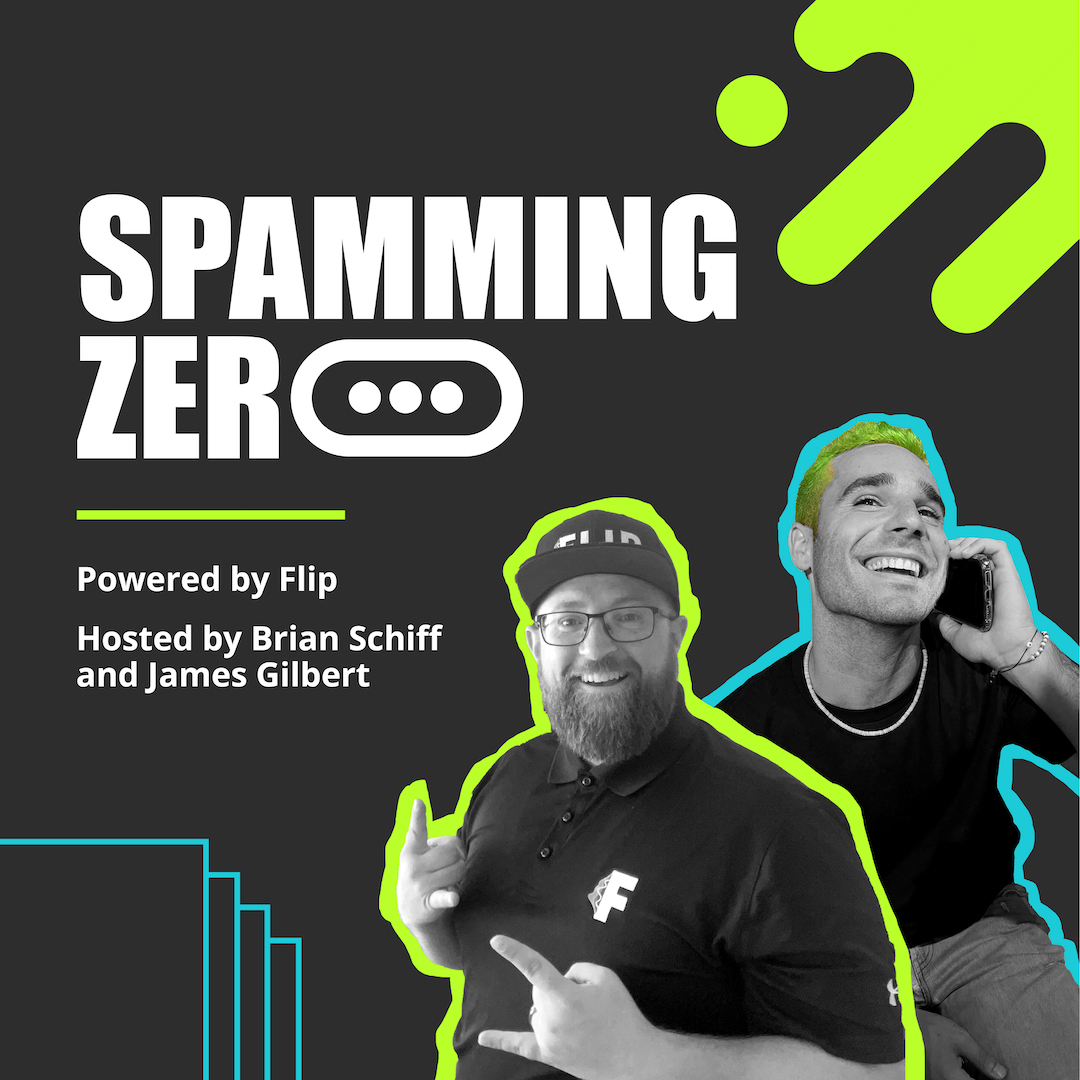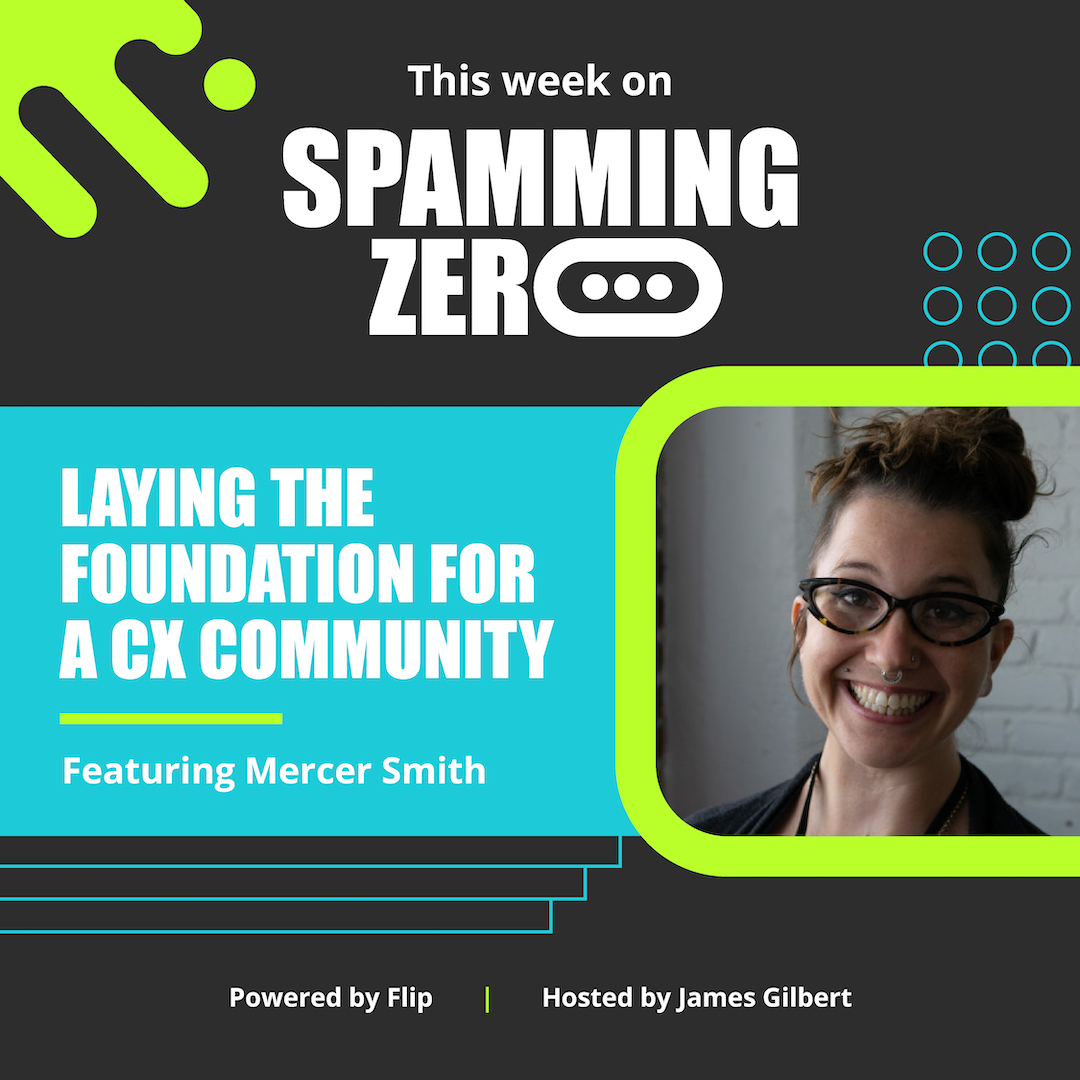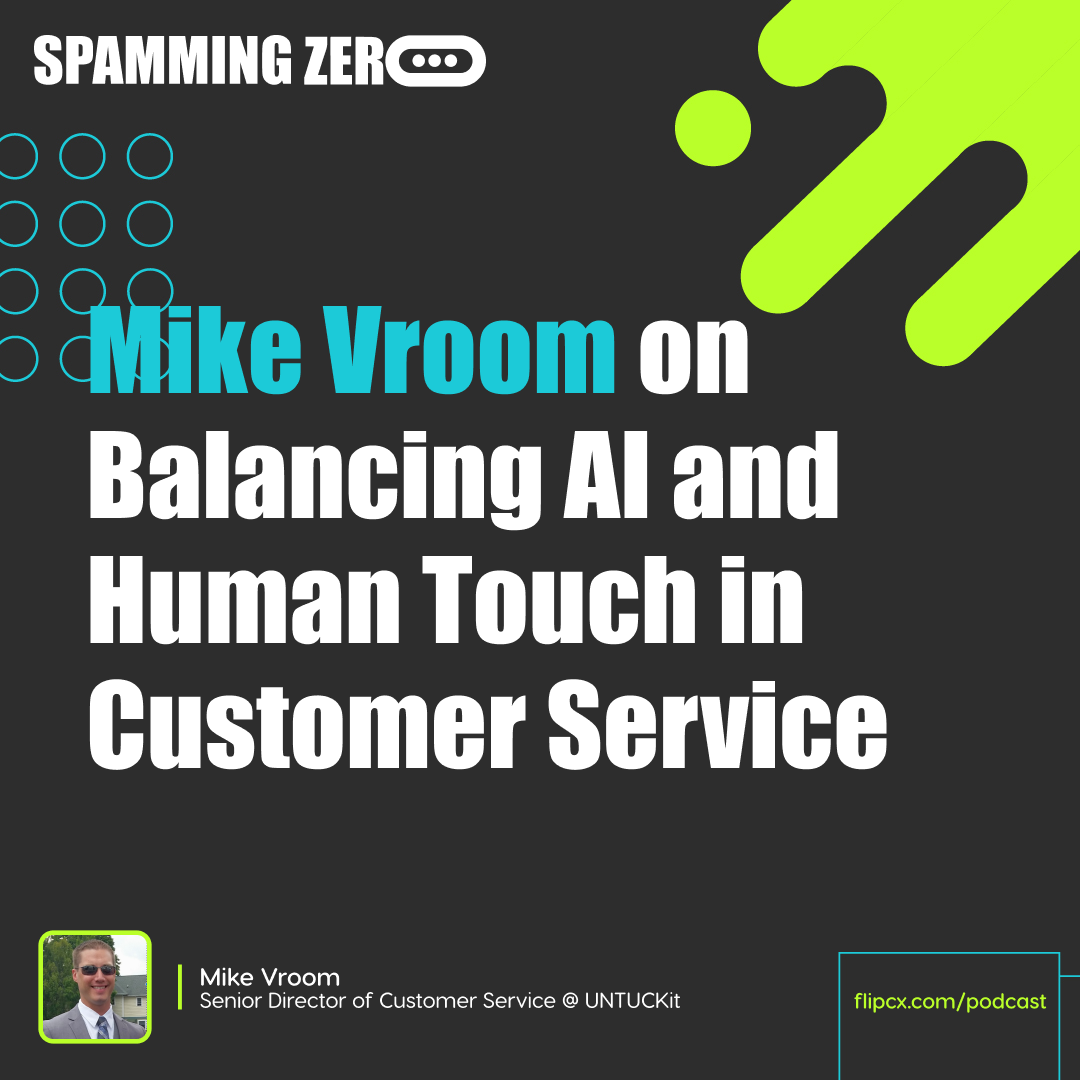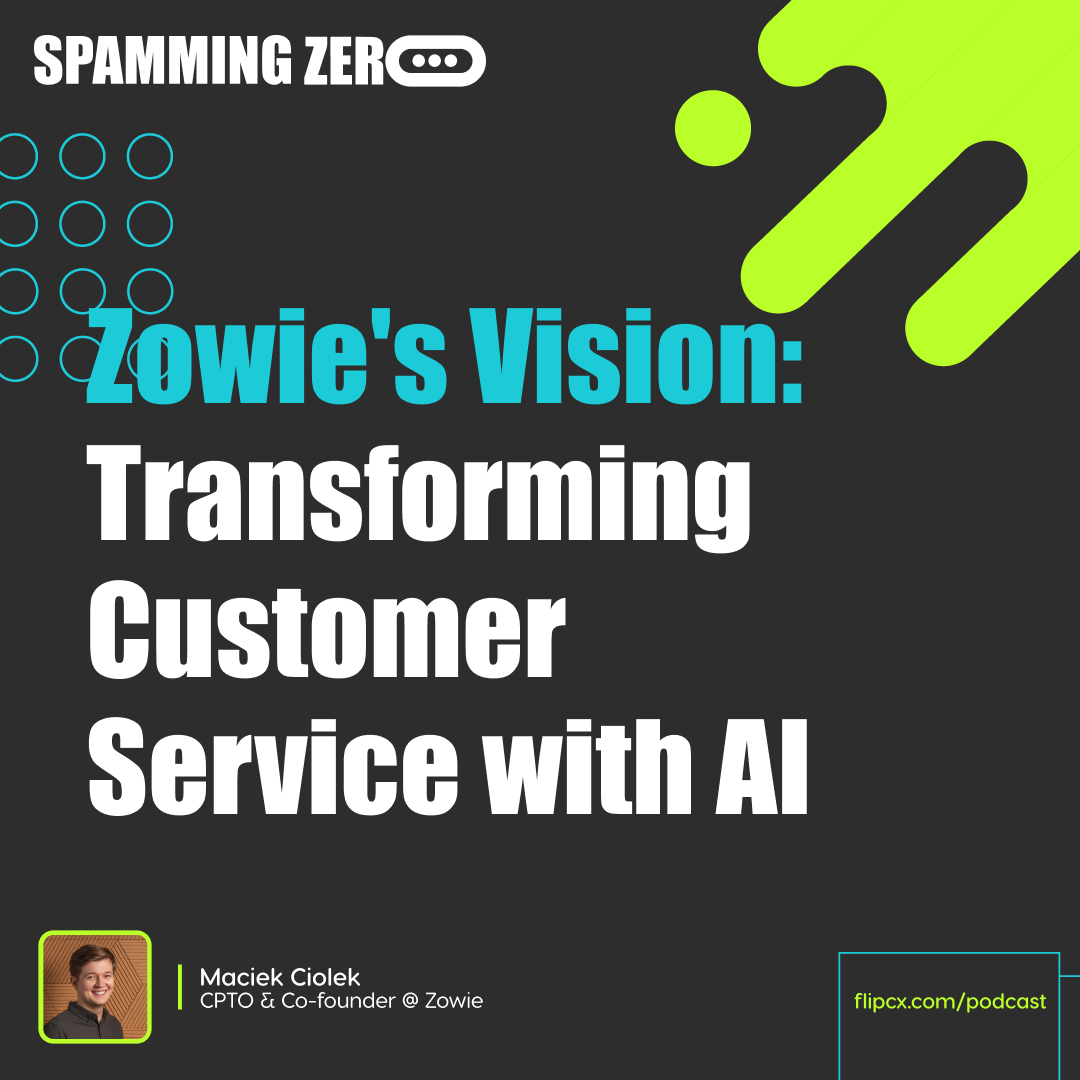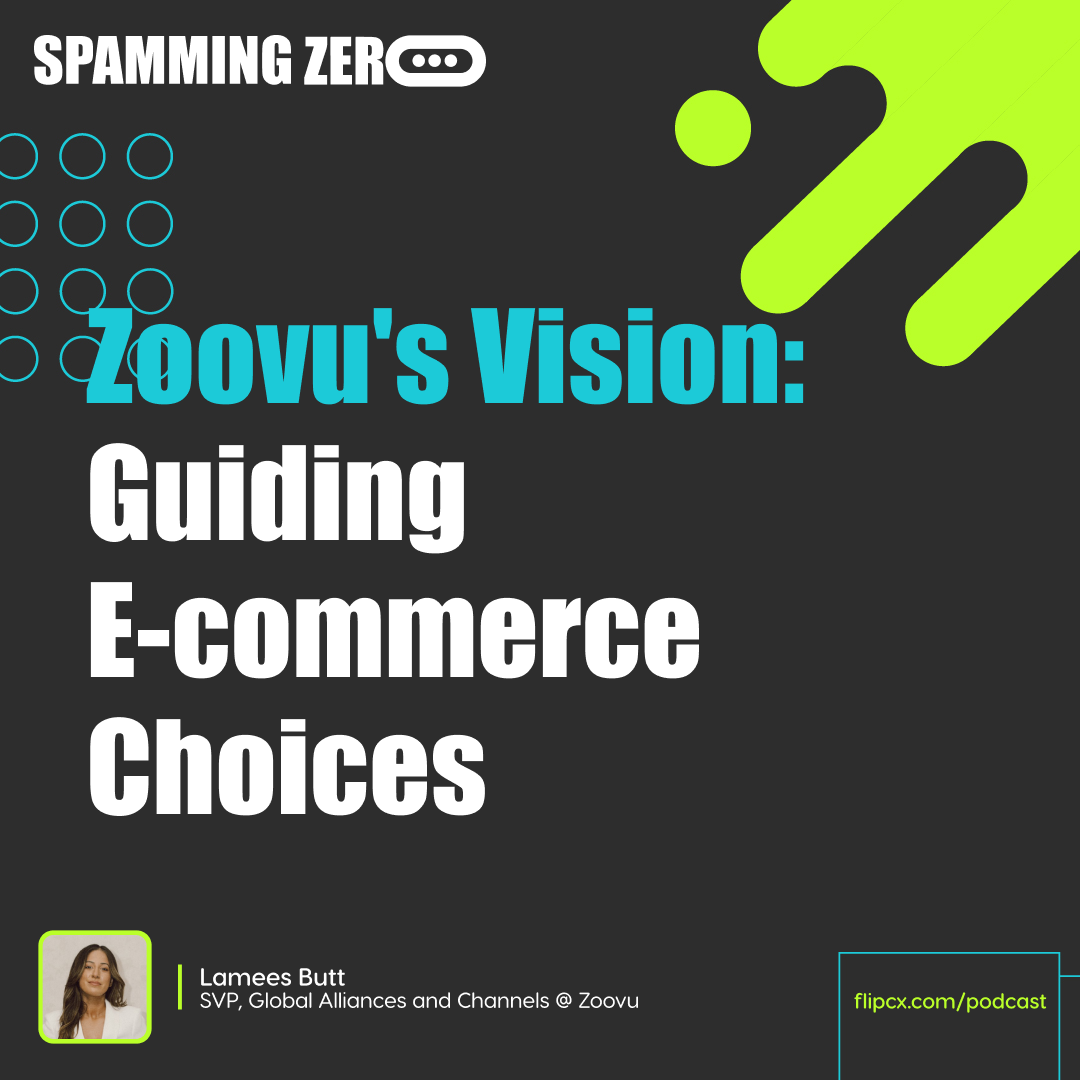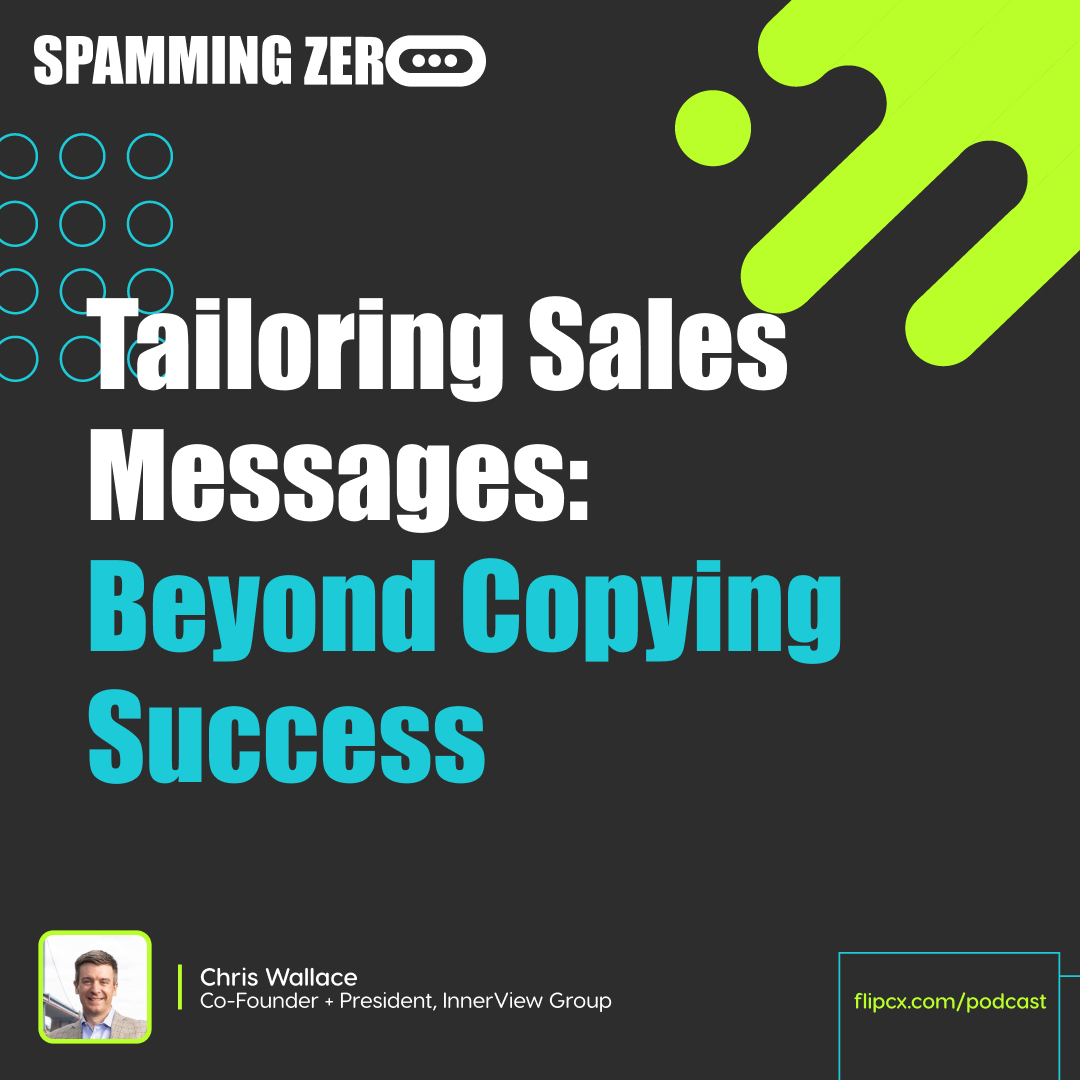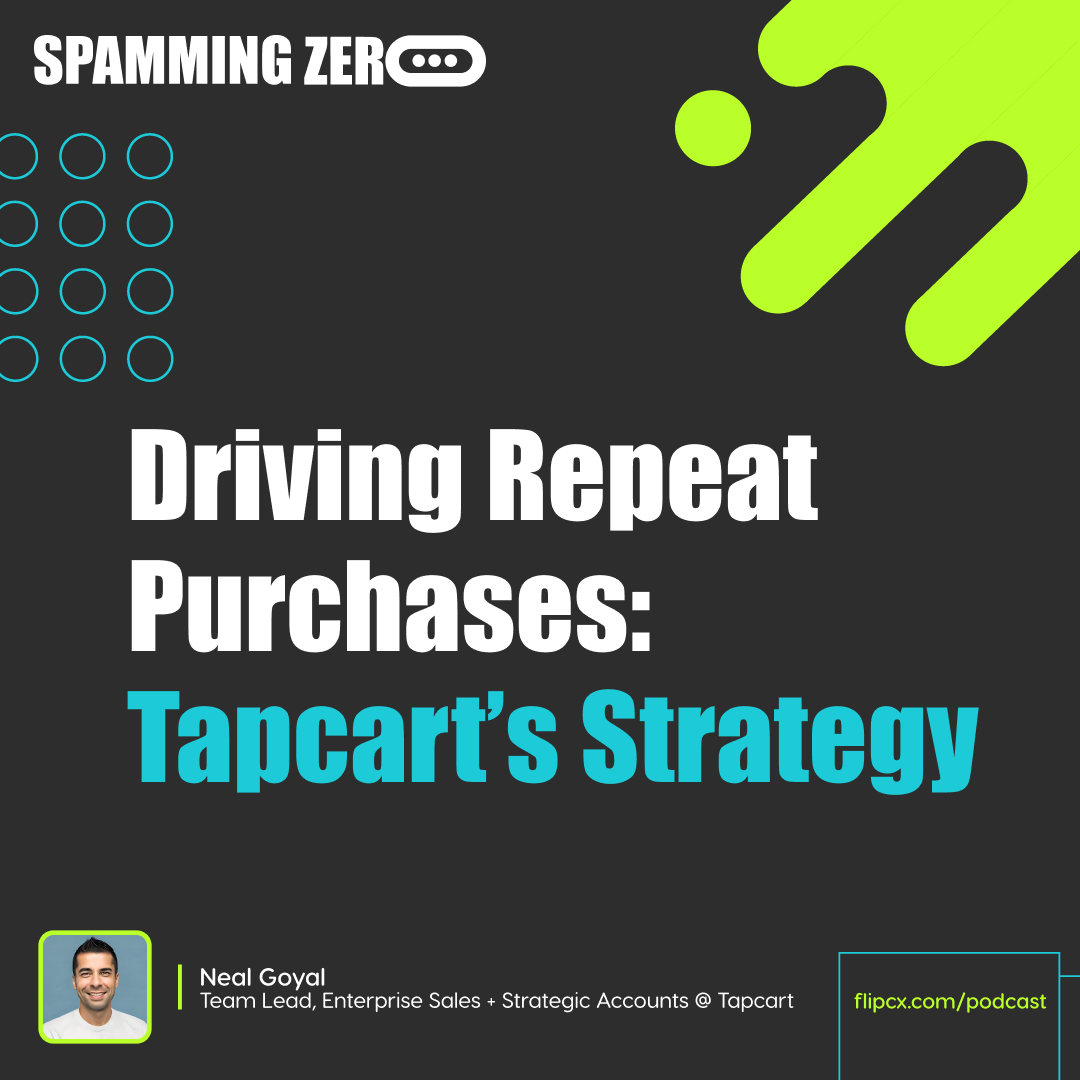Episode 43: Laying The Foundation For A CX Community with PartnerHero's Mercer Smith
- 0.5
- 1
- 1.25
- 1.5
- 1.75
- 2
James Gilbert: This month's sponsor of the podcast, Spamming Zero, is Kustomer with a K, kustomer. com. Go check Kustomer out today. They're amazing. They are your top- rated CRM for customer service. Finally, a CRM meant for customer service. They deliver fast, rich experiences to your customers with omnichannel messaging, a unified customer view, and AI- powered automations, like their AI chat, which comes with their product. Go check them out. They offer a free trial. They also have a slew of CX tools for customer experience professionals like yourself that you can use as well. And on top of that, they have brands like Glossier, Rappi, SKIMS, Ring, Hopper, and UNTUCKit all on their brand and using their product. They offer different types of solutions like self- service, artificial intelligence, of course, the CRM for customer service, and just customer service in general, so they actually can provide help desk features as well. Go check them out. They're amazing, and they're specifically meant for you. That's Kustomer with a K, kustomer. com. I'm James.
Brian: And I'm Brian.
James Gilbert: And this is Spamming Zero. Happy Monday, everybody. It is a Monday morning. Welcome to Spamming Zero. I'm your host James Gilbert, and we are joined by Mercer Smith. She is the VP of CX Insights& Community at PartnerHero. Welcome to the show, Mercer.
Mercer Smith: Thanks so much. I'm so excited to be here.
James Gilbert: It's funny because we were kind of playing a little bit of phone tag trying to get you on the show, but I was so excited to get you on though, and there's a lot of reasons why, but I just want the audience to get to know you a little bit. Can you give them just like who you are, why they need to listen to you today?
Mercer Smith: Yeah, sure. So I started in CX almost two decades ago, which is pretty bonkers to think about. Every time I say that, I'm like, " Really?" I started working out in Apple retail, and that was kind of where I began my support journey. But since then, I've been really privileged to work at some excellent companies, Trello, Atlassian, Campaign Monitor, Wistia, building teams and helping to define CX strategy. I built out Wistia's community from scratch a decade and a half ago, and I've continued to build up my chops at these great companies and learn from all the people on the way. And so I think I have some unique perspectives just across all of those experiences.
James Gilbert: 100%. I actually see that you're connected to a lot of the CX influencers that I follow as well. The Annette Franzs and the Nate Browns.
Mercer Smith: Yeah.
James Gilbert: That's like the CX community, for sure, and there's so many great people in there. I think the thing that I love most about the customer experience community is just how genuine people are wanting to help each other.
Mercer Smith: For sure.
James Gilbert: Well, let's talk a little bit about some of these journeys that you've been on. First of all, I didn't know that you had built the community at Wistia. I've been using Wistia for a long time. I love what they do. I love some of the newer stuff that they're doing as well. Talk to us about some of that. When they came out, building the community around video first was actually pretty unknown at the time, and Wistia was really leading the charge with that. That was before Vidyard came in and also was doing that, so talk about that because that's a little different.
Mercer Smith: Yeah. For sure. We hired a social media manager named Elise, and she and I worked together to really concept and build out the community. We decided instead of using a previously existing platform, we wanted to build ours from scratch. Brand was super important to Wistia. We were a marketing company. They still are a marketing company. But it was important to us that it fit our vibe. So we did a bunch of user research. We interviewed some of our top customers, asked them what they cared about, what they would engage in in the community, and we worked with our engineering team to build it from scratch. And then, we cultivated a strategy that was a little bit different from most communities. Reason being that it was video heavy, and video takes a little bit longer to produce and put together than a post or something like that. We really wanted our users to submit their videos. We wanted people to ask for feedback. And so we created this space based on that. It was not very small, but it was smaller than your typical community. You look at these CX communities now, there's like 1000, 3000 members, something like that. I don't think that would've been sustainable for us. And we had it only for customers. I think some of the biggest learning opportunities there was how to incentivize engagement. Like a community isn't going to stay alive if no one's in there and talking about it. So what are we going to do to try to get these people in every single day? What are we going to get them involved in? How are we going to get them to want to check this stuff, other than if they've posted? I think anyone who's in community or in CX knows if someone posts something, then of course they'll come and check back and be like, " Oh, has someone commented? Has anyone engaged?" Like, " What's going on?" But the incentive to come and look in a community when you haven't posted your own content yet is pretty slim, and so that was something that we really worked on. The way that we did that was a lot of Wistia- generated content. So we would have community updates and we would call out specific community members. So people were coming and checking to see what we were putting out rather than coming to check on comments of stuff that they'd put out. And I think that was a different strategy from how a lot of other companies were doing community and still are to this day. Wistia's community has changed a lot. I think they've actually moved to a not self- owned platform onto something that is developed and maintained by a third party. But that was, for sure, a learning opportunity for me and, I think, for the company as a whole.
James Gilbert: I love the value- first approach that you took, recognizing great work that people are doing. I can't announce it yet. We have something that we're doing here at Flip that's going to be pretty awesome for direct- to- consumer customer- experience professionals. And we are excited about it and stoked about it, so stay tuned for that.
Mercer Smith: That's awesome.
James Gilbert: But Mercer, I want to shift gears here for just a little bit. You're in a current customer experience role as a VP. When you're at that VP level in a customer- experienced role, it's tough, right?
Mercer Smith: Mm- hmm.
James Gilbert: Number one, you're having to work with executives that don't understand it. Let's be real here. They just don't. They're trying to, but they just don't get it.
Mercer Smith: Yeah.
James Gilbert: Number two, you're constantly having to fight for budget, and a lot of times, your budget in the customer experience realm of strategy is sometimes the first areas to get cut. Now, I don't want to lead into a biased take here, but what is your hot take right now when it comes to customer experience? You're in a role. You're at a VP level. Talk to the world about what it takes to manage this, and what is your hot take right now?
Mercer Smith: Sure. So my hot take, I'll take that one on first because I actually think it addresses some of the budget pieces that you're talking about. My hot take is that the big differentiator is going to actually be having humans and using humans on your team. So everyone and their mom is talking about AI and how valuable AI is, and how it's going to take all of our jobs, and all of these things. And while I agree that AI is useful, I think that we're going to start seeing a really sharp swing back to consumers, and this applies to B2B as well, wanting to work with actual human beings. We saw it with all of the smart technology. We have seen it time and time again. This trend repeats. People get really hyped about some new thing, and then it ends up the pendulum swings back, and there ends up being anti- sentiment around it. So I think my hot take is, while you should be leaning into AI, I don't think leaning as heavily into it as many people are is going to be a good path forward. Also, we have yet to see how impactful AI actually is, right? We're in the throes of this whole experience right now. We don't know what the outcome is going to be. So putting all of your eggs in one basket in that regard, I think, is ill- advised. I love AI. I'm building an AI product. I think that there's big opportunities for it, but I don't think that it's going to be the end all, be all that everyone thinks. And I also feel like customers are going to prioritize working with companies that they know have CX that's driven by humans rather than driven by machines.
James Gilbert: I couldn't agree more with you. Here's the thing. We talk a lot about this on the show, and it's no secret by this time to those that are listening to the show. We do AI at Flip, but it's a tiny fraction of the entire experience. We always say that to people. Like, " Listen, there are moments that people do prefer not to work with a human, but those are moments in the journey, and they're not the whole journey." We all work a certain amount of time in a day, and the worst thing in the world for me is when I get off work, and then this is the time that I get with my family, my four little kids who are growing up. I have a driver now, for Pete's sake. I'm running out of time with my children. I do not want to waste a single moment on the phone or in a chat with any customer service or support group during that time. And it's the only time that I can because of my work. And it's wild to me that I get off work and nothing's open. And I'm like, "Okay, so now I have to carve into my job." And I'm sitting here thinking to myself, I even did a post about this the other day, and I was like, " Listen, I should start charging businesses my hourly rate if I have to carve out." Because, one, they're making me wait on hold, right? I'm waiting on hold for 20 minutes. So you're not even helping me in that 20 minutes. It's a complete waste of my time. So I'm like, " What if we started charging businesses our hourly rate?" It's not too crazy of an example. I'm sure somebody's going to probably create a product for it.
Mercer Smith: I'm sure. I'm sure. That's funny. Yeah, because one of the questions that you asked me when we were prepping for this was, " What happens when you have to hit zero on a phone call for support?" And I was like, " As soon as that happens, I'm like, man, I really wish I could be emailing you." Because honestly, I would much rather wait a bit longer and just write off an email in two minutes than be sitting for an hour, however long it is, to be on a support phone call. I don't want to talk to you. I talk to people all day. I would rather just email you. I'm happy to wait. I will wait however long it is until you get back to me. You know what I mean?
James Gilbert: Yes.
Mercer Smith: Yeah, I feel the same way. I feel the same way.
James Gilbert: Mercer, I got a weird question to ask you. Here at Flip, a little while ago, we called it Our Big Flippin' Reveal when we rebranded to Flip. No one knew that we were actually going to be called Flip, so it was kind of a fun little pun.
Mercer Smith: That is fun.
James Gilbert: We had our founders do this challenge, and I was doing the challenge with them, and one of the challenges was they each had to dye their hair. Now, we had our CEO dye his hair the lime green, and we had our CRO dye his hair purple, and we had our CTO dye their hair this teal color. So it's all of our color palette, right?
Mercer Smith: Yep.
James Gilbert: How many different colors do you go through in a year?
Mercer Smith: Yeah. So actually, I go through the rainbow. So every single month, I move further in the color wheel. I start at red and go all the way through to purple. So usually, in a year, I'll make it halfway through the color wheel. So I'd say probably four or five with different variants of shades. But it's something I started doing at the beginning of the pandemic. I have kids too. I have a son who's six now, and his favorite color is rainbow. So anytime I was like, " What color should I dye my hair?" He's like, " Rainbow."
James Gilbert: Have you ever done a full rainbow on your hair?
Mercer Smith: No, I haven't. I've thought about it, but I'm worried that it would all bleed together and just be brown. So I haven't yet, but stay tuned. Maybe I will. Maybe I will someday.
James Gilbert: What's your favorite? Your son says, " Rainbow," but what's your favorite?
Mercer Smith: I really like dark blue, purple, like galaxy color.
James Gilbert: Oh, yeah. That's a good one.
Mercer Smith: I'm a big fan. Yeah, I'm a big fan. What about you?
James Gilbert: I actually got dared to dye my beard. See, there's this thing that my wife tells me all the time, and that's that if I ever touch my beard, it's over.
Mercer Smith: Okay.
James Gilbert: So that was off the table. I've not dyed my hair in the longest time. I think the last time I dyed my hair was when I was in high school, and I dyed it really dark black because I hated being blonde.
Mercer Smith: That sounds about right.
James Gilbert: I don't know. People said I looked like a vampire. I see pictures now of it, and I'm like, " Well, actually, yeah." I'm pretty pale white, and dying my hair black does not do it justice. You know?
Mercer Smith: Yeah.
James Gilbert: Oh, man. All right, so back on topic here. Let's talk more about this customer experience stuff and building community. I don't know if you've ever had a chance to read that book right there, the yellow one, but I highly recommend it.
Mercer Smith: Yeah. I have not, but I was looking at the other stuff. I'm like, " All right. I need to see what we've got here, see what I can read." I haven't read that one yet.
James Gilbert: This one's by Mark Schaefer, who is a great author in the marketing world. He wrote that once specifically about community, and each chapter goes through a real use case of a community that's being built, and some wild ones, like communities that are being built in the Metaverse, and stuff like that. It's a pretty awesome, pretty cool book.
Mercer Smith: Cool.
James Gilbert: But there's one example in there that I love, and it's by the lady who created Mom Boss. I don't know if you're familiar with Mom Boss, but she wanted a community that she could connect with other moms that are entrepreneurs and building their own businesses. And this thing grew like wildfire. I think it's still, to this day, the fastest- growing community in the world, maybe outside of Chat GBT now, because I don't even know if you can count that as a community. It went so fast, and that was because of exactly what we've been talking about, that value- first approach. And these moms needed a place to go and bounce ideas off, like, " Hey, I'm starting this retail shop," or" I'm starting a clothing line." Or heck, " I'm starting a Fortune 500 company that I want to eventually grow." There's lots of things here that I think people can relate to. So when you look at building community for PartnerHero, and you don't have to necessarily use the lens of PartnerHero, but just in general, what do you think people need to be thinking about? Our audience on this show is specifically direct- to- consumers and B2C, so what advice or tips would you give them?
Mercer Smith: Sure. I think if you're looking to build community in any space, the first thing that you need to do is understand what people care about and be able to put yourself in their shoes. Because if you're just building a community because you're like, " We need a community," or, " My product needs a community." It's not going to do what you want it to do. There are probably a select few people that care enough about your product to just join a community because, yeah, okay, you've got a product. But figuring out what your potential community members give a hoot about and want to spend their time talking about or engaging on is super important. So whether that be your actual product itself or unique ways to use your product, or just the things that your product empowers people to do, I think identifying that first before you even go into building a community is very important. For PartnerHero, we really strive to provide value for free. So one of my goals is to make PartnerHero University, which is a school for community and CX folks, and they can just come and take classes for free and maybe is accredited someday, all of this stuff, grand plans. And that's really what I built the community around is like, " Okay, how can we give as much back in terms of education and learning resources as we can for free?" And so there's a lot of peer mentorship that's in there. There's free book clubs. There's all of this free stuff that we're just giving away. Because that's ultimately what the people want in CX. Specifically, they want to learn from each other. They want to be able to connect. They're talkers and connectors primarily. Oats Overnight, for instance, has a bonkers community. I don't know if you've seen it or heard about it, but it's all on Facebook, and there's 1000s of members. There's like 300 posts a day. It's nuts. And they're all just talking about which oats flavors they like and what they've done with them. It's like, " Oh, today I took my S'mores Oats, and I made a s'mores oat pancake with whipped cream, and I added this syrup. So that's what they want to talk about. They want to share what they're doing with the product. I'm trying to think of some other products. Sourdough House is another one where they're not necessarily talking about what they're doing with their product. They're talking about something tangential to the product. So I guess the TLDR is, again, think back on what your community really cares about. If it's not directly related to your product, or it's tangential, you need to cultivate spaces for that within your community from the start in order for it to be burgeoning and also leave yourself a little bit of space to pivot. You can have some off- topic rooms or off- topic channels or whatever in case what you assume is the right option actually ends up being not what they care about.
James Gilbert: I love this because it's actually quite a simple thing to provide a place for people just to interact, but it's not happening very often. So just by doing that one thing, you're already going to be seen differently in people's eyes. And I especially think this is true when it comes to direct- to- consumer brands. I think about the community that Liquid Death is currently building right now. Everybody loves their social media. It's absolutely wild. This is no disrespect to them because I love what they're doing. I actually want to get them on the show. So gosh, dang it, you got to answer me. But they're selling water. If they can do that at this level and make it entertaining and fun, it doesn't necessarily mean that if you're a brand out there and that's not your brand essence or M. O., you don't have to necessarily go to the wild extremes that some are but providing an avenue where people can interact is key.
Mercer Smith: Yeah. And I think something that Liquid Death has done really well is audience assessment. I remember when Liquid Death first came out. I'm in the hardcore and punk communities. I am sober. I am their target demographic. I am the person that they want to buy their water. And so I've been getting Liquid Death ads for five years, or however long they've been around. So I think they know that, though. They know who I am, and they know what I want in my advertising and my branding. And I think that's the key thing. If they had tried to sell Liquid Death to anybody else, it wouldn't have been as much of a hit. They really found their target demo from the start and went after it. And then once they got and nailed that, then they kind of expanded outwards.
James Gilbert: Love that.
Mercer Smith: And I think that's the key success point, is that you see these brands that are really taking off, and I think that's probably why, because they're like, " Okay. We need to find some real niche. We need to target them first, get those super users, the super passionate people that really care about what we're doing, and then, from there, they can bring the tangential community on."
James Gilbert: I couldn't agree more with you. So let's talk about the intersection of customer experience and community because I think that they, in a lot of ways, go hand in hand. As you're building the foundations of a community, you've actually mentioned this on this show, is you have to build some of the foundational pieces of customer experience to understand what the true M. O. of what the community is going to need. So what's your advice on some of that in intertwining both of them? Because as you're doing your customer experience strategy, there's insights and data that you can also help empower and amplify the community.
Mercer Smith: This actually might be a hot take too.
James Gilbert: Ooh, we like those.
Mercer Smith: Yeah. Maybe just my life is a hot take. I feel like if you are just getting started with your CX strategy and you're like, " How do these two intertwine?" and you're asking that question, it might not even be the right time for you to start thinking about a community. It might be time for you to continue thinking on the individual pieces of the strategy first and really nailing those down one.
James Gilbert: But Mercer we need one. But we need one.
Mercer Smith: Yes, yes. And I'm like, "But maybe you don't. Maybe you don't yet. Maybe hold off on the community and focus on those other real key touchpoints." I don't know if you've read What Customers Crave. We're reading it in my CX book club right now, which is why it's top of mind.
James Gilbert: I was going to ask you, what's your go-to CX book? This is perfect. Let's do it.
Mercer Smith: Yeah. So we are reading that right now, so if you still want to get in on it, you can.
James Gilbert: I'd love to.
Mercer Smith: Anyone can. But it's a lot of fun. So What Customers Crave is really good. He's got five points in the life cycle of a customer, and it's all these different touchpoints. And it starts, obviously, pre- purchase. Someone's just coming. Anyone who's done customer journey mapping, this will sound familiar to you. But someone's just coming on. They find you via your website, via social media, whatever. They go through all of the buying points. They purchase your product or sign up as a user or whatever. And then the last touchpoint is what you're providing to them after all else has been done. You've delivered their product. You've given them customer support or customer success, or whatever, or self- service. What are you giving to them after all of those opportunities? And the answer to that is community. I think community comes into play there. So if you don't have all of those other things set up already, let's not talk about community. Let's figure out those other things that they need to get to that endpoint first.
James Gilbert: And let's actually unpack this for a second because, let's say you try to build a community, and you don't do the things Mercer just said. Let me give you an example of what's going to happen. The social proof is going to go backwards for you. The community is going to be built around how shitty your experience is.
Mercer Smith: Yes.
James Gilbert: That's the opposite of what you want.
Mercer Smith: Right.
James Gilbert: And then your revenue generation when it comes to your customer experience is going to go to kaput, and that's not what you want. To your point, I think there's a lot of people out there that are doing exactly what you're saying. They're trying to build a cart before the horse, or is it the... Yeah, it's the cart before the horse.
Mercer Smith: Build a cart before the horse. Yeah.
James Gilbert: You know? And you can't do that. You've got to get the foundational pieces down. A lot of people talk about, even myself. I talk about wow moments and the brand experience and things like that. I keep hearing so many people talk about like, " Forget the wow moments, just serve the person. That's wow enough." And to be honest, it's true, the experience that we all have with customer service with, I want to say, primarily D2C brands. Okay. Here's why I say that because the B2B world is a little bit different on how they go about customer service and all of that, even though I still think there's a considerable problem there. But for the most part, we all can relate to having to call a brand or a service or business, like our internet provider or our cell phone company. All of these are direct to consumers, and the customer service is just fundamentally broken. It's really bad. It's so bad, in fact, that if you handle and resolve the situation that is social proof enough for the person to go and be like, even though you created a terrible experience for them to begin with, for them to call or reach out to you, that alone is enough for people to brag about you.
Mercer Smith: Yeah. Yeah. It's called the service recovery paradox.
James Gilbert: It's wild to me. I'm like, " This is not hard. You have a really low bar, a really, really low bar, and making incremental improvements here and there, wow."
Mercer Smith: Buc- ee's won the Forbes Best Customer Experience Award this year. Buc-ee's, that's a gas station, and the reason was because they have clean bathrooms. I was like, " People should have clean bathrooms." I love Buc- ee's as much as the next person, but you should have clean bathrooms. That should not be the thing that gets you an award. You shouldn't shock people by having clean bathrooms. Do you know what I mean?
James Gilbert: I completely agree with you. It's the simple stuff.
Mercer Smith: Yeah.
James Gilbert: Oh, wow.
Mercer Smith: Yeah. And then I was thinking about what customer experiences have really wowed me, and it's like MeUndies did a return for me really easily. They were just like, " Oh, yeah. No worries. We'll do a return." And I was like, " Oh, my gosh. This is amazing." That's just what it should be.
James Gilbert: No hassle. Just like, " Yeah."
Mercer Smith: The moments where I am really wowed are that. Like, "Oh, okay." MeUndies being like, "Yeah. Okay. We'll just send you another one. No worries. You don't need to do anything for us."
James Gilbert: That's how it should be, though. If you were them, why not?
Mercer Smith: Right.
James Gilbert: Why are we over complicating it? I want to actually ask you because I believe the shirt you're wearing is a punk band, is it not? Kerbey Lane?
Mercer Smith: It's not. It's a diner in Austin. I
James Gilbert: I could have sworn. Isn't there a punk band named Kerbey? I think there is.
Mercer Smith: I don't know. Maybe. Probably. I'm sure there is. If not, we could make one.
James Gilbert: Why not? I can play piano.
Mercer Smith: Cool. I can play lots of instruments. I have some guitars back there, so we could do it.
James Gilbert: Yeah, we got this.
Mercer Smith: Yeah.
James Gilbert: We're going to need to find a drummer because the drummer is usually hardcore for the punk.
Mercer Smith: Yeah, that's true. Were you going to ask me about punk music, or do you want to talk about Kerbey Lane? They've got great customer experience too. I love them.
James Gilbert: I want to actually ask you about your favorite punk music right now. Give me the top three.
Mercer Smith: My favorite punk music right now?
James Gilbert: Top three.
Mercer Smith: Oh, man. That is hard. I listen to a lot of old punk, so I'm pretty much stuck back in the day. But I think right now, I really love this band called The Beths. They're kind of pop- punky. Have you heard The Beths? Do you know The Beths?
James Gilbert: I have not, but I love learning about new music. It's a really fun thing for me, so I'm all about it.
Mercer Smith: They're from New Zealand, and so they're actually The Beths if we're being honest about what they're called, but they're really cute. It's a girl- fronted band. It's like a pop- punky situation. I saw them at South by Southwest three years ago, and I've just really loved them. Who else am I listening to a lot?
James Gilbert: What about your old- school punk?
Mercer Smith: I love the Ramones, which I guess is also pop- punk technically. My first ever punk record was Ramones Mania. It was from my mom.
James Gilbert: Nice.
Mercer Smith: And I don't know. I was 10 or something like that. Leftover Crack is a band that I really enjoy, which I don't say very often.
James Gilbert: Oh, that's a good one. That's a good band name.
Mercer Smith: Yeah. Yeah. Yeah, that's a good one. And I listen to Fugazi. My younger six- year- old son really likes Fugazi, so that's a good one. And yeah, I think those are the three ones that I've been listening to a lot of recently. Home Front is one.
James Gilbert: I haven't heard of Home Front.
Mercer Smith: Yeah. I just discovered them via a Spotify Discover, so they're really good too.
James Gilbert: My wife has been stuck in this punk phase. We'll go on a drive or something, and she'll throw on a bunch of'90s punk.
Mercer Smith: Nice.
James Gilbert: I think that punk changed a lot too, right?
Mercer Smith: For sure.
James Gilbert: I don't know who technically revolutionized that genre, but I think one of the biggest players in that genre, at least for me growing up, was Blink- 182, Sum 41. Those are the ones. And then it started getting a little bit more crazy, at least what the world consumed as crazy. Right?
Mercer Smith: For sure.
James Gilbert: I remember going to the Warped Tours as a young kid. You know what I'm talking about?
Mercer Smith: Oh, 100%. Yes.
James Gilbert: And you have the Coheed and Cambrias, and you know what I'm talking about. This guy has this crazy high voice but just is hitting all these, ah. Oh, man.
Mercer Smith: They just came out with a new album, Coheed and Cambria.
James Gilbert: I know. I know. That's why I'm saying my wife's on this kick. Now we're listening to all this'90s stuff based on the fact that Coheed and Cambria comes out with a new album, and now we're listening to punk music. It goes from punk music to'80s rock and anywhere in between. And then sometimes she'll just throw on music, and I'm like, " What is going on?"
Mercer Smith: Yeah. You and my partner probably would have some stuff to talk about. I'm the same way. Snoop Dogg has affirmations for children now.
James Gilbert: Oh, my goodness.
Mercer Smith: So sometimes we'll be listening to that. It'll be like Leftover Crack to Snoop Dogg's affirmations to video game music. So, yeah, I get it.
James Gilbert: That's all right. I appreciate almost all music. The only one that I can't quite get on board with is the really hardcore heavy metal. It's not really my thing.
Mercer Smith: I agree.
James Gilbert: Mostly because I like the dynamics of music. You know?
Mercer Smith: Mm-hmm.
James Gilbert: Where it's got to build up to something, and it's not just in your face the whole time.
Mercer Smith: Yes, I agree.
James Gilbert: But I do get why people listen to it. It is a stress reliever, so more power to that.
Mercer Smith: For sure.
James Gilbert: I want to end the show because we are getting to time here, and I just want to ask you one more quick question.
Mercer Smith: Sure.
James Gilbert: What is your favorite brand right now that you follow or that you admire?
Mercer Smith: Ooh, I think my favorite brand right now is Great Jones. Do you know Great Jones?
James Gilbert: No. No, I don't actually.
Mercer Smith: Great Jones is a bakeware and cookware company. They're D2C. They make really beautiful crockery, and their brands are really funny names. They've got really funny names for sheet pans. And they just came out with measuring cups that they've got really fun names for. And also they're extremely aesthetically pleasing. So we've got the Caraways and the everyday pots and pans, which I also own, but Great Jones, I think, is doing it really well. They've found their target market, and they're really nailing that home. I would recommend looking them up. They're doing it really well.
James Gilbert: So wait a minute. If that's one of your favorite brands, that means you like to cook, too.
Mercer Smith: I do. I love to cook. Yes.
James Gilbert: What's your go- to dish?
Mercer Smith: I cook this thing called fried pasta, which is a take on an Italian dish of leftover breakfast pasta. I don't know if you've ever had breakfast pasta, but you take the pasta from the night before, and its sauce and stuff, and you put it in a pan with eggs. It's like fried rice, but with pasta. And that's effectively what this is. I cook a bunch of angel hair pasta. I mix it with pesto, Alfredo, and some Parmesan, and eggs. And then I put it in a pan, and I let the bottom caramelize, so the bottom is all crispy, crunchy, cheesy situation. And then I flip it over a giant pasta, latke pancake, and I let the other side do the same thing. And you cut it into slices.
James Gilbert: This is what your partner and your six- year- old love the most is this? Right?
Mercer Smith: Yeah.
James Gilbert: Would we be able to confirm with these two that this is the dish that is their favorite in the home?
Mercer Smith: Yes. I think, at least, my six- year- old would say that. My partner would probably say the meal that I cook for holidays is his favorite. But really, it's the fried pasta if we're being honest.
James Gilbert: Okay. That's fair. So thank you so much for joining us today, Mercer. You've been awesome. We've had a good time.
Mercer Smith: Yes. Thank you so much for having me. I really appreciate the opportunity to get to talk about these things. And thank you for taking the time to ask me questions. I appreciate it.
James Gilbert: Of course. If you have not yet subscribed to the podcast, do so. We'd love to hear from you as well. So reach out to me on LinkedIn if there's a topic or if there's somebody that you'd like us to have on the show. Let us know. We'd love to have them.
DESCRIPTION
Community. It’s a word that’s being thrown around in the CX world a lot these days, and for good reason.
But, real talk: If you’re considering building a community, you better make sure you lay a solid foundation for it.
If not? Well... is it even worth creating?
It’s a topic that Mercer Smith, VP of CX Insights and Community at PartnerHero, tackles head on. And, she offers some pretty brilliant advice - this week, on Flip CX’s Spamming Zero Podcast.
What’s Covered?
- A bit about Mercer’s 2 decades in CX
- How she built the Wistia community from scratch
- Mercer’s hot takes on CX right now
- Top Tips for preparing to build a community
- Intertwining customer experience and community
- The service recovery paradox
- Liquid Death, hair dye, punk bands
- And more
Ready for more fantastic Spamming Zero conversations ahead? Listen, rate, and subscribe on YouTube, Casted, Apple Podcast, or Google podcasts.
Today's Host
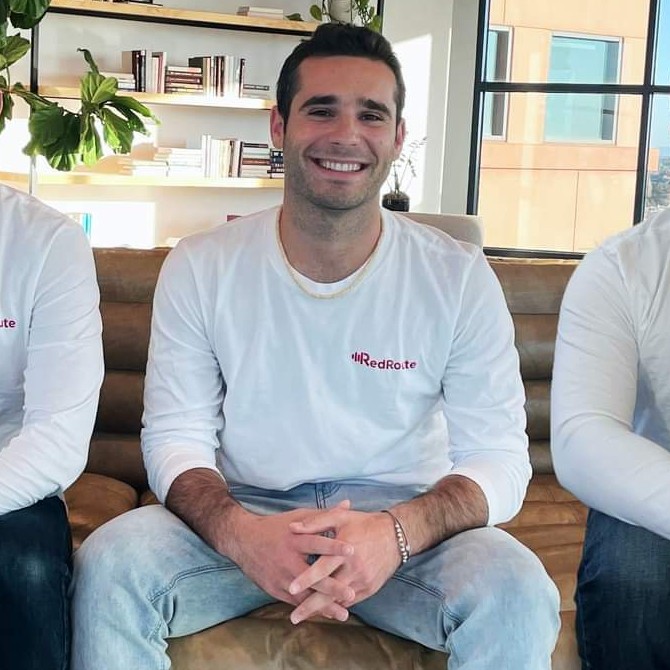
Brian Schiff
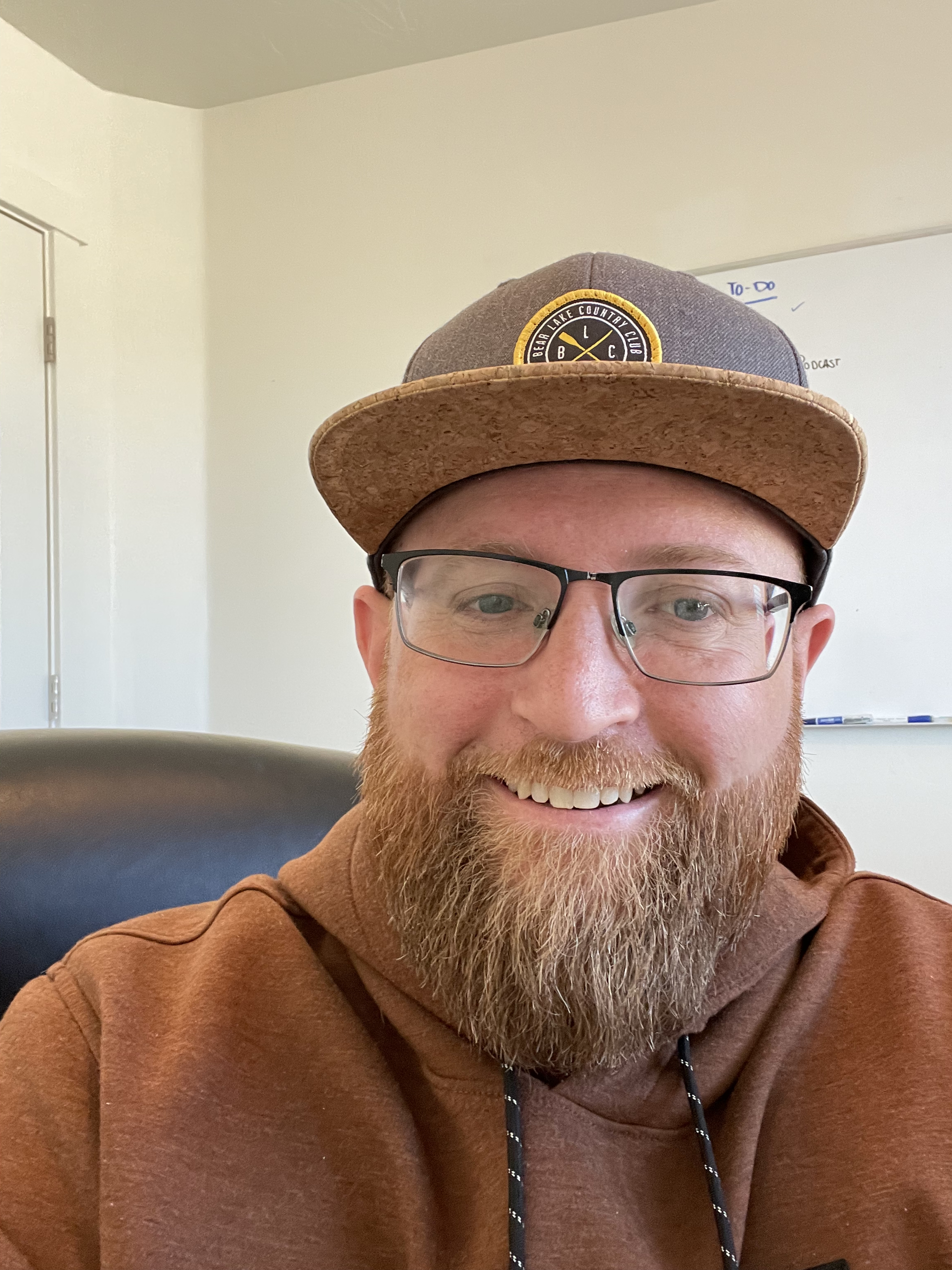
James Gilbert
Today's Guests

